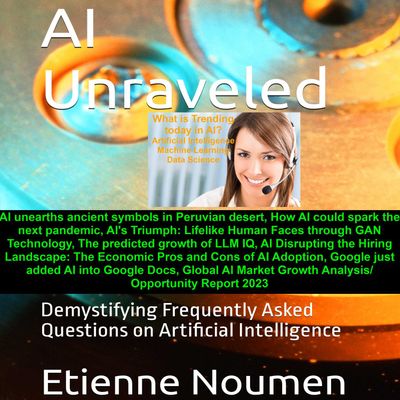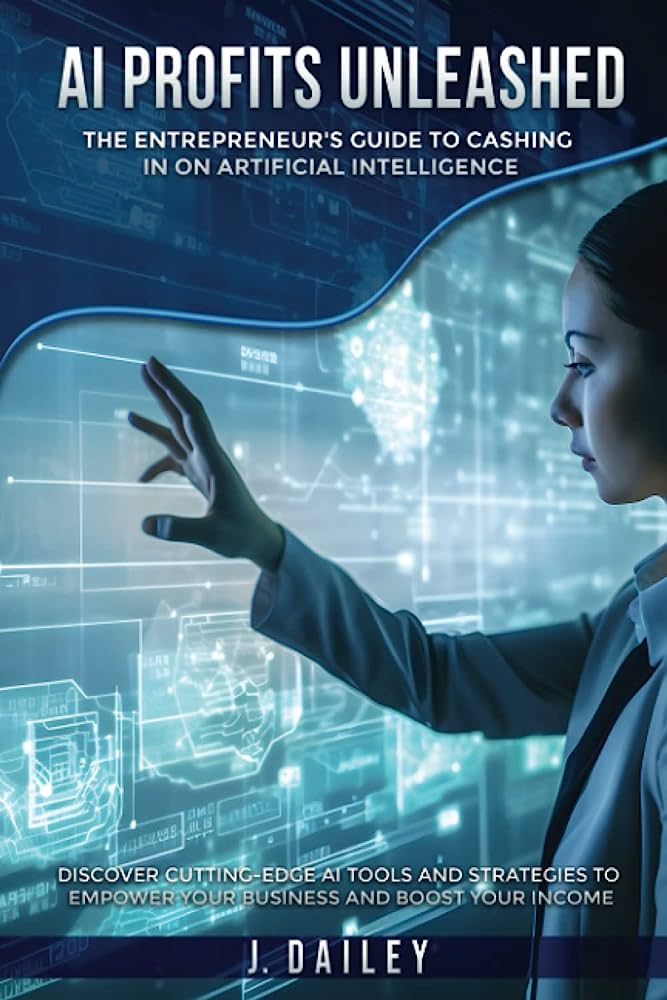Introduction: The Promise of AI in Business
It is without doubt that artificial intelligence (AI) has been a major disrupter in today’s digital-driven world, influencing every nook and corner of the business landscape. From automated customer service to data-driven marketing strategies, AI is revolutionizing how we conduct business. Undeniably, AI is not just a tool for efficiency; it’s a catalyst for profit generation.
Artificial Intelligence: A Catalyst of Profit
The power of AI to drive profits stems from its ability to automate and streamline various business functions, substantially enhancing productivity and efficiency, and reducing costs. But it doesn’t stop there. AI can also provide invaluable insights into customer behavior, enabling businesses to create personalized customer experiences, leading to increased customer satisfaction, loyalty, and ultimately, increased revenues.
Another potential for AI is its ability to open up new revenue streams. By leveraging AI technologies, businesses can create innovative products and services, create new business models, and penetrate new markets, leading to additional income.
The Rapid Advancement of AI Technologies
From chatbots to sophisticated machine learning algorithms, the rapid advancement of AI technologies is astounding. Every day, we’re seeing breakthroughs in AI that push the boundary of what’s possible. More importantly, these advancements are making AI more accessible to businesses of all sizes. Today, even small businesses can leverage AI technologies to boost their bottom line.
All these make AI an indispensable tool in the business arsenal. The question now is not whether we should adopt AI or not, but how to adopt it to drive profits. This article will delve into this question in detail, providing a comprehensive guide to monetizing AI in online business.

This image is property of influencermarketing.ai.
Understanding Key AI Terms
In the innovative world of Artificial Intelligence (AI), there are countless opportunities for businesses to capitalize on this technology to generate profits. However, to really understand how to monetize AI, it is important to comprehend certain key terms used in this field. Let me take a moment to explain how these terms tie into the financial advantages that AI offers.
Recognizing the Power of Machine Learning
Machine Learning is a method that allows a system to learn from data and improve over time. This means the system acquires knowledge and builds on that base without being explicitly programmed. Now, I can hear you ask, how does that contribute to monetizing AI? It’s simple, really. Machine learning can improve efficiency, predict consumer behavior, and enrich customer interaction. With refined data, businesses can immensely improve their decision-making process, thereby enhancing the products and services they provide, increasing profitability.
The Relevance of Natural Language Processing
The next term I’d like to discuss is Natural Language Processing (NLP). NLP involves the interaction between computers and human language, helping machines to understand and respond to text or spoken words in ways that are both meaningful and helpful. From a monetization perspective, NLP is key for AI tools like chatbots, voice recognition, and sentiment analysis. These focus on improving customer service or transforming big data into valuable insights. Better customer service can contribute to customer satisfaction and loyalty. On the other hand, valuable insights from big data help businesses tailor their strategies to ensure maximum profitability.
So remember, understanding these key AI terms is the first step towards exploring this technology’s potential to monetize your business.

This image is property of media.licdn.com.
Road to Monetization: Profiting from AI
Artificial Intelligence (AI) has become a game-changer in recent years, impacting almost every aspect of our lives. Its potential to transform businesses and enhance profitability is immense. In this section, I will delve into the world of AI and how it can be monetized to augment revenue streams.
Using AI To Drive Revenue
The advent of AI has opened new avenues for businesses to explore. AI simplifies customer interactions and enhances user experience. For instance, AI-powered chatbots have become increasingly popular in online businesses as they serve customers round the clock, reducing the need for human intervention and thereby, cutting down operational costs. They can handle multiple queries simultaneously and offer personalized recommendations, which boosts customer engagement and sales. Moreover, AI-driven predictive analysis can be utilized to predict market trends, consumer behavior, and sales probability. This allows businesses to strategize their sales tactics and marketing campaigns effectively, resulting in increased revenue.
Optimizing Business Operations with AI
AI isn’t only about revenue generation. It’s also about optimizing business operations to maximize profitability. AI can streamline various operational processes such as inventory management, quality control, supply chain management, and HR processes. For instance, AI-based automated inventory systems reduce stock-outs and overstock situations, minimizing losses. AI also supports in enhancing decision-making through predictive modeling and data analysis.
To sum up, the successfully monetizing AI is a strategy that combines revenue generation and operational efficiency. Businesses looking to gain a competitive edge must explore the myriad opportunities offered by AI and build strategies to leverage its potential fully. Remember, the goal is not just to implement AI but to monetize it too!

This image is property of img.rss.com.
Chatbots: AI’s Front Row in E-Commerce
In my journey of unraveling the potential profits in AI, one of the areas that caught my attention was the use of chatbots in e-commerce. AI-based chatbots have rapidly risen to the forefront, revolutionizing the way businesses interact with their customers. They provide a convenient, interactive, and efficient way for businesses to monetize AI.
Improving Customer Experience with Chatbots
Customer experience is paramount to any business. Bear in mind, a happy customer is a returning customer and possibly, a referring customer. Strikingly, AI chatbots can play a significant part in improving this customer experience.
Chatbots, with their ability to engage in human-like conversations, can provide immediate responses to customer inquiries. This eliminates the need for customers to wait in long queues to receive support. Additionally, chatbots can provide product recommendations based on the customer’s browsing history and preferences, leading to a more personalized and saffisfying shopping experience.
Increasing Conversion Rates through AI Chatbots
Now, let’s talk about conversion rates. This is where the money comes in, right? Interestingly, AI chatbots can really help to boost these rates. By using sophisticated algorithms, they can analyze a customer’s behavior to identify potential buying signals.
Once a signal is identified, the chatbot can engage the customer with personalized messages promoting products related to their expressed interest. This nudges them further along the buying funnel, significantly increasing the chances of converting a browsing customer into a buying one.
AI chatbots are a bridge connecting businesses with their customers in a more personal and efficient manner. By improving the customer experience and increasing conversion rates, they play an instrumental role in monetizing AI in e-commerce.

This image is property of enoumen.com.
AI in Marketing: A Paradigm Shift
Marketing has evolved leaps and bounds from its traditional form, and AI’s integration into this field has turned it into an arena of endless possibilities. AI has not only changed how we market products and services, but also how we monetize these efforts.
Using AI For Predictive Analysis
One of the most powerful applications of AI in marketing is predictive analysis. Using historical data and complex algorithms, I can predict future trends and behaviors. This allows me to anticipate what my customers need even before they know it themselves. With this knowledge, I can create targeted campaigns that resonate with my audience, leading to increased conversions and profits.
Moreover, AI-driven predictive analysis also helps in improving customer retention. By identifying patterns and behaviors that indicate a potential churn, I can take immediate action to retain the customer. This proactive approach helps me save on customer acquisition costs and boost profitability in the long run.
Target Marketing with AI: A Game Changer
Another revolution brought about by AI in marketing is the concept of target marketing. AI’s ability to analyze massive amounts of data means it can identify patterns and segment the market with surgical precision. Since every marketing campaign I launch can now reach the exact demographic, my ROI from marketing spend has significantly increased.
And it doesn’t stop at just making the initial sale. AI’s advanced analytics allows me to understand my customers better. This information helps me in not only upselling and cross-selling but also in designing better products and services.
In a nutshell, the marriage of AI and marketing is a game-changer. It not only increases efficiency in marketing operations but also helps in monetizing these efforts better. Whether it’s predicting customer behavior or targeting the right audience, AI’s possibilities are almost boundless.

This image is property of Amazon.com.
Unraveling Profits: The Guide to Monetizing AI
The time has come when the immense value of artificial intelligence (AI) is not just a fancy tech jargon. Instead, it is rapidly finding its way into mainstream industries and our daily lives. As a result, turning AI into an income generator has become a hot topic among tech enthusiasts, startups, and global enterprises. I will prolongate the discussion highlighting the significance of AI and data in making profitable decisions, further emphasizing on monetizing AI through understanding customer behavior with advanced analytics.
Turning Data into Profits with AI
Harnessing the power of AI to turn data into profits is no sci-fi anymore. Businesses today are leveraging machine learning, a subset of AI, to dig deep into their vast data pools to unearth insights that were previously unavailable. By doing so, they have been able to identify profit-making opportunities while predicting and mitigating potential risks. This kind of advanced, real-time analysis enables businesses to make strategic decisions faster, providing them with a competitive edge.
Understanding Customer Behaviour with AI Analytics
AI can also play a critical role in understanding customer behavior. With AI analytics, businesses can analyze their customer’s interactions, preferences, sentiments, and more, making way for them to provide personalized experiences. This level of customization can enhance customer satisfaction and loyalty, leading to increased revenues. Furthermore, AI analytics can point out the patterns and trends in customer behavior, which businesses can leverage to develop targeted marketing campaigns.
In essence, the road to monetizing AI isn’t simple- it requires the right blend of top-notch AI technologies, a vast amount of data, and the ability to harness these with precision. However, with careful planning and execution, businesses can unravel unknown profit-making opportunities with AI. The future is bright for those ready to tread this path.
AI in Product Development: Optimizing Innovation
The landscape of product development is evolving rapidly; a big part of that change is due to the integration of Artificial Intelligence (AI). With its ability to support automation, refine processes, and offer valuable insights, AI is playing a significant role in optimizing innovation in product development. Let’s delve a bit further to understand how AI is making this possible.
Improving Product Life Cycle with AI
In my experience, AI can predict and track the life cycle of a product more efficiently than traditional methodologies. The AI systems use predictive analysis to identify patterns and make projections based on historical data. As such, it can forecast product performance, aiding in marketing strategies, optimizing inventory management, and reducing waste. Moreover, AI can help streamline the entire product development process, right from the conceptual stage to the post-production phase, enhancing the speed and quality of the process.
Driving Innovation through AI Integration
To me, the most exhilarating aspect of AI in product development is its potential to drive innovation. From analyzing customer behavior and their evolving needs to creating product designs that satisfy those needs, AI tools can do it all. They can even transform raw data into actionable insights, providing a rich source of inspiration for new product ideas.
In essence, monetizing AI is not just about integrating technology into your operations. It is about strategically leveraging the capabilities of AI to improve product development processes and, consequently, increase revenues. With a clear understanding of the potential that AI holds and practical strategies to exploit this potential, businesses can significantly enhance their profitability.
Remember, ultimately, it is the well-planned execution of AI integration that translates into tangible business profits.
Mitigating Risks in AI Investments
Introduction: I’ve often been asked about how to monetize AI in online business. Well, as promising as AI might seem, it’s essential to understand the potential risks associated with AI investments. In this section, we’ll discuss the challenges surrounding AI integration and the precautions to take while investing in AI technology, which will ultimately lead you toward better monetization outcomes.
Understanding the Challenges of AI Integration
The first barrier to successful AI integration is understanding the technology itself. AI systems are complex and require a significant amount of resources to maintain. Additionally, data privacy is a major concern. AI systems require access to vast amounts of data, which can come with security risks.
Precautions While Investing in AI Technology
I always recommend taking calculated steps when it comes to investing in AI. Firstly, thorough market research is a must. Understand the specific opportunities and limitations of AI in your industry. Secondly, make sure your business is ready for integration. This means having the right infrastructure, data management processes, and team skills to support AI technology.
The journey to monetizing AI might seem daunting, but with the right approach and careful risk management, the benefits can greatly outweigh the challenges. It’s about harnessing the power of AI, but also remembering that it’s a tool—an incredibly powerful one, but a tool nonetheless. Remember, central to AI monetization is aligning AI capabilities with your business goals, as this ensures that your AI investments contribute directly to enhancing your profitability.
Future Prospects: AI in Coming Years
As we continue to embrace the cutting-edge advancements in technology, it is important to reflect on the impact of Artificial Intelligence (AI) on various business sectors. The ability to monetize AI in a business environment is a crucial game-changer and a powerful asset that is rapidly revolutionizing the way we interact, market, and do business.
Evolution of AI in Business
AI has undeniably transformed the business world. It started as a discreet tool to automate processes and has evolved into a sophisticated engine driving decision-making, customer interactions, and even product development. Chatbots, for instance, started as basic Q&A tools and have now evolved into virtual assistants that provide personalized shopping experiences and nuanced customer service. AI-driven data analytics is another area that has been a game-changer, providing enhanced decision-making abilities.
Future Developments and Trends in AI Technology
Looking ahead, AI promises not just to change our techniques but completely revolutionize the business landscape. It’s not about who has the best innovative business model anymore. It’s about who utilizes AI most efficiently. The future of AI includes several trends like an increase in machine learning applications, the advent of AI-powered decision-making tools, and the evolution of AI into an everyday utility. Furthermore, the integration of AI with other technologies like the Internet of Things (IoT), blockchain, and advanced analytics will create endless opportunities for growth and profitability.
Hence, understanding these transformations and adapting to these changing trends is instrumental for businesses to thrive in today’s competitive landscape. To successfully monetize AI, we must be willing to evolve, integrate, and innovate constantly. Every entrepreneur out there needs to be ready to unlock the untapped potential AI offers. After all, AI is not just a tool, it’s an investment for a better, lucrative future.
Case Studies: Success Stories of Monetizing AI
As we embark on this insightful journey, let’s delve deep into the world of AI-enabled companies that have struck gold. In this section, we will identify how AI has been instrumental in reshaping businesses and gaining unprecedented profits.
Learning from the Success of AI-driven Companies
Case studies serve as real-life evidence of what AI can achieve when applied strategically in business. For instance, Netflix’s movie recommendation system or Amazon’s predictive purchasing enabled by machine learning AI, have transformed their business models and driven significant profits. Their success underscores the immense potential that AI holds when efficiently monetized.
Through their innovative monetization strategies, these industry giants have not just found a competitive edge in AI but also evolved their customer experience. Netflix analyses user viewing patterns and provides personalized recommendations. With these accurate recommendations, Netflix gains customer loyalty, leading to increased user engagement and subsequent profits. Similarly, Amazon’s AI technology predicts future purchases based on user shopping habits, promoting desirable products and influencing customer purchase decisions, resulting in boosted sales.
Recounting these remarkable manifestations of AI monetization, it’s clear that AI can serve as a catalyst to significant profit gains, provided its potential is effectively harnessed.
Practical Examples of Monetizing AI
Unifying AI with business objectives can yield profitable outcomes. We can scale up customer service with AI chatbots, minimize overhead costs, lower risk margin, and accelerate business growth. Online businesses have witnessed considerable improvements in their revenues and operational efficiency with the introduction of AI. AI chatbots have not only reduced the burden on human personnel but also crafted a more personalized customer experience thereby significantly improving revenue generation.
Through these case studies and practical examples, we can decipher that there’s a mine of gold in AI, waiting to be unraveled. This journey, indeed, has been one of discovery, unraveling the immense potential of AI, and monetizing it to stride towards success in the digital world. In a world where technology is rapidly advancing, artificial intelligence (AI) has become a game changer for many businesses. From automating tasks to reducing costs and amplifying returns, AI has untold potential in creating multiple sources of revenue. However, unlocking these profits involves a bit more than just integrating AI into your business models. That’s why I’m here to unravel the steps to develop an AI monetization strategy and turn it into profitable actions.
Starting with an AI Strategy
The first and arguably the most critical step in monetizing AI revolves around creating an effective AI strategy. Now, you might be asking, “- why’s that?” Well, an AI strategy defines the scope, scale, and success factors for employing AI in a company. It’s the blueprint that helps businesses identify viable ways to garner value from AI and chart a clear path to profitability. The strategy may include investing in AI technologies for streamlining operations, improving customer interaction, or even building AI-driven products or services. Remember, an AI strategy that’s tailored to your business needs, capabilities, and market realities is the key to successful monetization.
Turning Strategy into Profitable Actions
Once you’ve got your AI strategy in place, the next step is to translate it into profitable actions. Here, it’s all about generating ROI from your AI investments by transforming the strategic plan into actionable tasks. Implement the AI technologies and systems, align them with your business goals, and optimize them for maximum efficiency. It’s about being tactical in your approach and not being afraid to experiment and iterate. Remember, AI monetization isn’t a one-size-fits-all, so be prepared to continuously refine your approach and adapt as necessary. The end game here is to use AI not just to increase efficiency and reduce costs, but to also create new sources of revenue and drive growth– that’s when you’ve truly mastered the art of monetizing AI.
Conclusion: Monetizing AI for Sustainable Profits
In wrapping up our journey through the landscape of unleashing profits: the guide to monetizing AI, I want to conclude with some pivotal points.
Recap of Benefits and Challenges of AI Monetization
The journey of AI monetization is dotted with both benefits and challenges. On one hand, we can’t ignore the significant revenue potential AI holds with the right strategies such as enriched customer experience, operational efficiency, and competitive edge over others in the market. Yet, we also need to account for the inherent challenges that can pose potential roadblocks in our pursuit. This includes the need for substantial upfront investments, data privacy concerns, and the difficulty in predicting the ROI on AI projects.
Reaffirming the Profitable Path with AI
Despite the challenges, I remain firm in the belief that AI monetization is a rewarding undertaking. Practical applications of AI already permeate industries, from health to manufacturing to entertainment. As I’ve stressed throughout this guide, success lies in fully understanding the best paths to AI monetization in your unique context. It’s about aligning AI technologies to your business strategic objectives, building algorithms that solve real problems for real people, creating sustainable revenue models, and fostering a culture of continual learning and adaptation.
In essence, monetizing AI is much more than a sprint towards increased profits – it’s a marathon towards sustainable growth, competitive advantage, and organizational transformation.
So buckle up, because the journey towards AI monetization isn’t easy, but with careful planning, a steady resolve, and an unwavering focus on addressing core learning gaps, it can certainly prove to be profitable.
